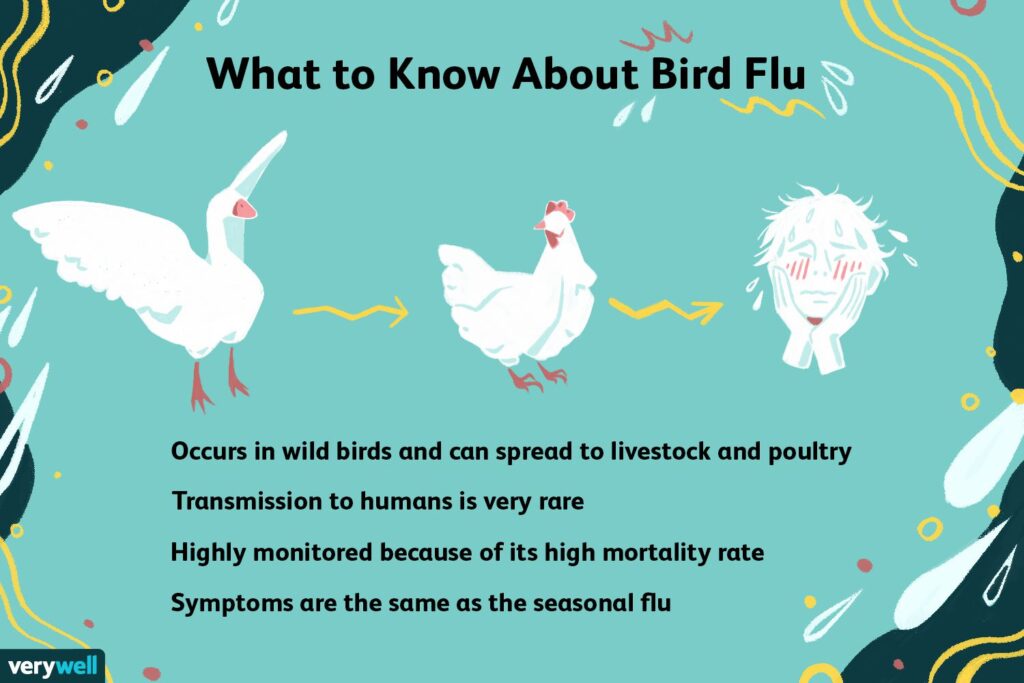7 Common Bird Flu Symptoms in Humans
Bird flu, or avian influenza, is an infectious disease that primarily affects birds but can occasionally spread to humans. While human cases of bird flu are rare, they can occur through direct contact with infected poultry or contaminated environments. Understanding the symptoms of bird flu in humans is essential, especially for individuals who are exposed to birds or live in areas where outbreaks are more common.
In this blog post, we’ll discuss the 7 common bird flu symptoms in humans, what they look like, and when you should seek medical attention.

1. Fever
Fever is one of the most common early signs of bird flu infection. In humans, it is usually accompanied by other flu-like symptoms. The fever caused by bird flu can be high, often reaching temperatures above 100.4°F (38°C). It may come on suddenly and is often accompanied by chills or sweating.
- What to watch for: A high fever, often higher than typical colds or mild flu, is one of the first signs of infection.
- Why it happens: A fever is your body’s natural response to infection, as it helps fight off the virus by making it harder for the pathogen to survive.
2. Cough
A persistent cough is another common symptom of bird flu. Like other respiratory infections, the virus can affect the lungs, leading to coughing. It might begin as a dry cough and then progress to a more productive, mucus-filled cough as the infection spreads.
- What to watch for: If you develop a cough that lasts longer than usual or is associated with other flu-like symptoms, it’s important to consider bird flu, especially if you’ve been exposed to infected poultry.
- Why it happens: The avian flu virus primarily targets the respiratory system, causing inflammation and irritation in the airways.
3. Sore Throat
A sore throat is another symptom that can accompany bird flu. This occurs due to the inflammation caused by the virus, similar to how a sore throat develops during a regular cold or flu.
- What to watch for: The pain may range from mild irritation to severe discomfort while swallowing.
- Why it happens: The avian influenza virus causes swelling and irritation in the throat tissues, leading to pain when swallowing or talking.
4. Muscle and Joint Pain
Muscle and joint pain are common flu-like symptoms that can occur with bird flu. You may experience aching in your muscles, especially in your arms, legs, and back, along with joint discomfort.
- What to watch for: Sudden onset of body aches that feel more intense than a typical cold or other flu illnesses.
- Why it happens: The body’s immune response to the infection can cause inflammation, which leads to muscle and joint soreness.
5. Fatigue and Weakness
Fatigue and weakness are also common in bird flu infections. Patients often feel extremely tired, even after a full night’s sleep, and may have difficulty performing routine daily activities. This fatigue can be severe, leaving you feeling drained for an extended period.
- What to watch for: If you are experiencing an overwhelming sense of fatigue or weakness that interferes with daily tasks, especially with other flu-like symptoms, it could be a sign of bird flu.
- Why it happens: The body’s immune system is working hard to fight off the virus, which takes a toll on your energy levels.
6. Respiratory Distress
In more severe cases, bird flu can lead to respiratory distress, which is characterized by difficulty breathing, shortness of breath, or wheezing. This is more common if the infection progresses to pneumonia, which can severely affect lung function.
- What to watch for: Difficulty breathing or a sensation of tightness in the chest. If you are struggling to take deep breaths or notice a bluish tint to your lips or face, seek medical attention immediately.
- Why it happens: The virus can lead to severe pneumonia or other complications, such as inflammation of the lungs, which impairs oxygen exchange.
7. Gastrointestinal Symptoms
In some cases, bird flu can cause gastrointestinal symptoms, such as nausea, vomiting, diarrhea, and abdominal pain. These symptoms may appear along with the other flu-like symptoms and can sometimes be confused with stomach flu or food poisoning.
- What to watch for: If you are experiencing stomach discomfort, vomiting, or diarrhea alongside other symptoms like fever, cough, or body aches, bird flu should be considered, especially if there’s a history of exposure to infected birds.
- Why it happens: The virus can occasionally affect the digestive system, causing inflammation and leading to GI symptoms.
When to Seek Medical Help
If you experience any of the above symptoms and have had recent exposure to poultry or areas where bird flu outbreaks are occurring, it’s essential to seek medical attention immediately. Early detection and antiviral treatment can significantly reduce the severity of the illness and help prevent complications.
Warning Signs to Watch For:
- Difficulty breathing or shortness of breath
- Bluish lips or face
- Severe fatigue that doesn’t improve with rest
- Chest pain or tightness
- Confusion or disorientation
How to Prevent Bird Flu
While there’s no guaranteed way to avoid bird flu, there are a few steps you can take to minimize your risk:
- Avoid contact with sick birds: If you work in poultry farming or live in an area with reported bird flu cases, wear protective clothing and avoid touching sick or dead birds.
- Practice good hygiene: Wash your hands frequently with soap and water, especially if you handle birds.
- Cook poultry thoroughly: Ensure that all poultry and eggs are cooked to an internal temperature of 165°F (73.8°C) to kill any potential virus.
- Get vaccinated: While there is no specific vaccine for bird flu in humans, the seasonal flu vaccine may offer some protection, as flu strains can mutate and spread between birds and humans.